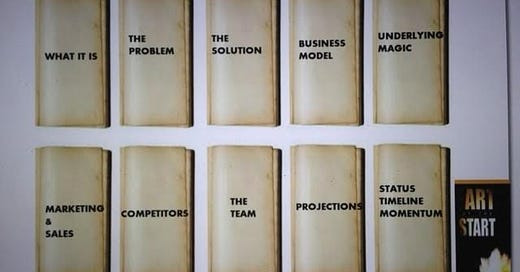How to Tell if You Have a Good Idea for a Business
Ten slides that reveal and (help you think through) the viability of a notion.
“Can I run something by you?”
I love to hear this.
People come to me with their business ideas all the time.
After I hear their idea and discuss it with them, I almost always tell the person to try the same thing: do a “Kawasaki.”
At first, they’re not sure if I mean hop on a motorcycle or what.
I’ll explain.
A Kawasaki is a framework. 10 magic slides, in fact.
Ten slides created by Guy Kawasaki.
You see, Guy Kawasaki gets pitched about 100 ideas a week.
And if you’ve ever traipsed through any part of the internet with keywords like “entrepreneur” or “starting a business,” you have no doubt come across the energetic, charming, suffer-no-fools Mr K.
In a previous life, Guy Kawasaki was Steve Jobs’ “Chief Evangelist” for Apple. In this position he headed up promotion and marketing. In effect, he was the “hype man” for Apple. (“Chief Evangelist” was the title on his business card, btw.)
He’s now, once more, a Chief Evangelist and an in investor in the popular creative software company, Canva.
Guy has a lot of great presentations on the web to see. And several good books to read.
Today I want to share his 10 slides.
I’ve used this Kawasaki method throughout my career whenever I’ve had or heard an idea for a business.
It really helps to see what you’ve got.
These slides are explained by Guy in his fine book, “The Art of the Start.”)
So, without further ado, the 10 Kawasaki slides and some explanation of them. They are the perfect filter/blueprint if you have an idea for a business (or if you’re pitching an idea in general):
Slide 1: What It Is
This needs to be a smart, pithy statement. For example, “The world’s first AI-only museum.” Or the “Trybrid Car: it runs on gas, electric and hydrogen.” Or the “Bestie Agency: An ad agency that specializes in TikTok.”
Whatever your idea is — express it on the first slide. It might be all a buyer or investor sees.
Slide 2: The Problem
What burning problem are you solving?
Slide 3: The Solution
Here’s where you show how your idea is really the best (and maybe the only) idea to solve the problem you’ve identified.
Slide 4: The Business Model
How will your idea make money? What kind of business is it? Subscription? Fee-based? Direct Sales, etc.
Slide 5: Underlying Magic
The most critical slide. What makes your idea special?
Slide 6: Marketing & Sales
How are you going to get this idea of yours famous? And who is your specific audience? How are you going to convince them to open up their Venmo accounts and hit send?
Slide 7: Competitors
Who else is out there? Who’s doing what you’re doing?
Slide 8: The Team
You and what army? Or maybe it’s you as a solopreneur.
Slide 9: Projections
What’s the financial picture look like? Twelve months from now you expect how much revenue? In 2 years? 3? How big can you get before you sell? Or takeover a competitor? Or simply break-even?
Slide 10: Status/Timeline/Momentum
Where are you on the journey? Where and when is the next milestone?
And that’s it.
Ten questions that answered well will let you know if you have a good business idea. And 10 slides that can form the basis of your pitch deck.
What’s your idea?
See if you can run it on a Kawasaki.




